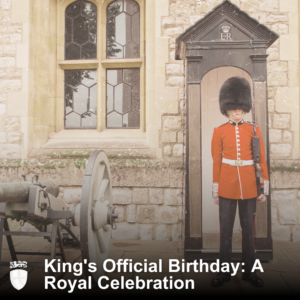
The upcoming King’s Official Birthday is set to be a magnificent event, steeped in tradition and pageantry. As we prepare to celebrate King Charles III’s official birthday on Saturday, 15th June 2024, join us in exploring the rich history and contemporary significance of this special day. From the grand Trooping the Colour parade to the royal family’s attendance, this celebration promises to be an unforgettable spectacle. Read on to learn more about the customs, key highlights, and the significance of this cherished occasion.
Table of Contents
- The History and Meaning of the King’s Official Birthday
- The Trooping the Colour Tradition
- The Significance of the King’s Official Birthday
- The Event: Trooping the Colour Parade
- Queen Elizabeth II’s Parades
- King Charles III’s First Official Birthday Parade
- What to Expect: Schedule and Highlights
- The Royal Family’s Attendance
- Frequently Asked Questions
The History and Meaning of the King’s Official Birthday
Origins of the Celebration
King Charles III’s official birthday, celebrated on 15th June 2024, is an event of great significance across the Commonwealth realms. Although King Charles was born on 14th November 1948, the official celebration occurs in June to ensure better weather for public festivities.
The tradition of marking the sovereign’s official birthday dates back centuries. Initially, the celebration was tied to practical military purposes, such as the daily parade of regiment Colours to ensure soldiers recognized their own insignia.
The Trooping the Colour Tradition
Trooping the Colour has become the cornerstone of the official birthday celebrations. This grand military parade, involving over 1,400 soldiers, 200 horses, and 400 musicians, showcases the precision and discipline of the British Armed Forces. The tradition dates back to the reign of Charles II in the 17th century and has evolved into a significant ceremonial event.
The Significance of the King’s Official Birthday
Symbolism and National Unity
The King’s Official Birthday is not merely a celebration of the monarch but also a symbol of the unity and continuity of the Commonwealth realms. It brings together people from diverse backgrounds to honor their sovereign, reflecting on the monarchy’s enduring role in modern society.
Reflection of Tradition and Modernity
This event blends historical significance with contemporary relevance. The pomp and ceremony of Trooping the Colour, combined with the presence of the royal family, foster a sense of national pride and connection to heritage.
The Event: Trooping the Colour Parade
The Parade Route and Activities
The parade begins at Buckingham Palace, travels down the iconic Mall to Horse Guards Parade, and returns to Buckingham Palace. The event concludes with a spectacular Royal Air Force flypast viewed by the royal family from the palace balcony.
Participants and Spectacle
The parade involves over 1,400 soldiers, 200 horses, and 400 musicians from ten military bands. Each year, different regiments take turns leading the parade. This year, the Irish Guards will have the honor, a moment underscored by Kate Middleton’s message to the regiment.
Queen Elizabeth II’s Parades
Historical Participation
Before 1987, Queen Elizabeth II would attend the parade on horseback, dressed in the uniform of the regiment whose Colour was being trooped. After 1987, she attended in a carriage, maintaining the tradition while adapting to her comfort.
Evolution Over the Years
The Queen’s participation evolved over the years, reflecting changes in both the monarch’s role and public expectations. Her steadfast presence at these parades exemplified her dedication to tradition and public service.
King Charles III’s Official Birthday Parade
Adaptations for Health Reasons
King Charles III, currently undergoing cancer treatment, will participate in the parade via carriage this year. This adaptation ensures his comfort while upholding the tradition of royal participation.
Continuing Traditions
King Charles’ decision to attend in a carriage, similar to Queen Elizabeth II’s later years, highlights the royal family’s commitment to tradition while adapting to current circumstances.
What to Expect: Schedule and Highlights
Parade Details
The parade will begin around 5 a.m. ET on Saturday, traveling from Buckingham Palace, down the Mall, to the Horse Guards Parade, and back. Upon arrival at Horse Guards Parade, the royal party will take a viewing position on a balcony overlooking the parade ground.
The Royal Air Force Flypast
After the parade, the royal family will return to Buckingham Palace and assemble on the balcony for the Royal Air Force flypast, marking the culmination of the celebration.
The Royal Family’s Attendance
King Charles III
King Charles III has confirmed his attendance, participating in a carriage due to health reasons. This marks a continuation of the royal tradition while accommodating his current health needs.
Kate Middleton
Kate Middleton, honorary Colonel of the Irish Guards, has expressed her regret at missing the rehearsal due to her cancer treatment. Her attendance at the main event remains uncertain, but she may join the royal family on the balcony for the public wave.
Speculation on Other Attendees
The attendance of Prince Harry and Meghan Markle, along with their children Archie and Lilibet, remains speculative. Their participation would add another layer of interest and family unity to the occasion, but is unlikely as they have stepped back from their previous roles as senior royals since 2019, and last attended during the Queen’s Platinum Jubilee Celebrations.
Frequently Asked Questions
Will the King attend, given his recent return to duties?
Yes, King Charles III has confirmed his attendance , but at the advice of his medical team, will be participating in a carriage rather than riding as planned.
Will Kate Middleton attend?
Kate Middleton’s attendance is speculated but not confirmed. She may join the royal family on the balcony for the public wave.
Will Harry and Meghan attend?
Their attendance is not confirmed, and whether they will bring their children is also uncertain.






